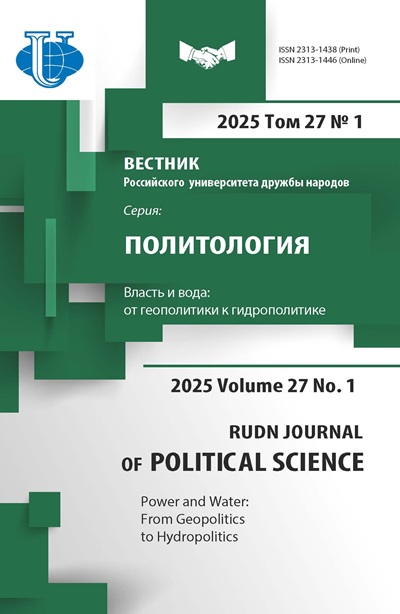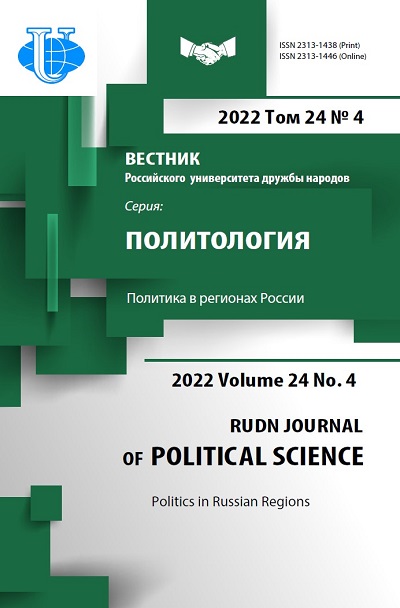Higher Education as a Resource for Regional Development: The Case of Krasnodar
- Authors: Rakachev V.N.1, Morozova E.V.1
-
Affiliations:
- Kuban State University
- Issue: Vol 24, No 4 (2022): Politics in Russian Regions
- Pages: 827-855
- Section: YOUTH IN POLITICS IN RUSSIAN REGIONS
- URL: https://journals.rudn.ru/political-science/article/view/32828
- DOI: https://doi.org/10.22363/2313-1438-2022-24-4-827-855
Cite item
Full Text
Abstract
One of the main intangible resources, along with regional and local identity, is human capital. Multiplying human capital is one of the main functions of the education system, including higher education. The theoretical framework of the study is defined by the concept of responsible development (I.S. Semenenko), the theories of “triple helix”, “preceding events” (path dependence) of P. David and “track of dependence”. The empirical base is represented by the results of a sociological study, held among students of Krasnodar universities in June 2022. As part of comprehensive analysis, documents of regional authorities and administration, and data from federal and regional statistics were used. The Krasnodar Krai was initially formed and integrated as an agricultural region; thus, the system of higher education focused largely on training specialists for agriculture and related industries. Structural transformations that began in the 1990s changed the region’s vector of development. The rapid progress of the resort and recreational industry, and enterprises of the tertiary sector influenced both intra-regional and inter-regional migration. The universities of the Krasnodar Krai are attractive to educational migrants from other regions of the country - from both the neighbouring Southern Russia regions and the north-eastern regions. At the same time, from the point of view of global competitiveness, the region has systemic problems in the development of human capital, innovation, and space. The authors focus on the educational trajectories of students, the reasons for their choice of Krasnodar as education destination, satisfaction with the quality of educational services, the degree and forms of social activities, as well as further life and professional plans. The authors identified three contradictions in the current state of the region’s higher education system, without the resolution of which it will be impossible to convert human capital into a real factor of regional development. These are the contradictions between the significantly growing population of the region and the reduction in the number of students, between the needs of the labour market of the “knowledge economy” and the structure of specialists’ training, and between the governmental trend for the development of rural areas and the lack of motivation among university graduates to work in rural municipalities. The article formulates several proposals for resolving these contradictions.
About the authors
Vadim N. Rakachev
Kuban State University
Email: midav.sf@mail.ru
ORCID iD: 0000-0002-6505-4208
Dr. Sci. (History), Professor of the Department of Sociology
Krasnodar, Russian FederationElena V. Morozova
Kuban State University
Author for correspondence.
Email: morozova_e@inbox.ru
ORCID iD: 0000-0002-1369-7594
Dr. Sci. (Philosophy), Professor of the Department of Public Policy and Public Administration
Krasnodar, Russian FederationReferences
- Alexandrov, D.A. (1997). Organization of university departments as a factor of development spiders: Germany, USA, Russia // In Yu.S. Vasiliev & S.A. Kugel (Eds.), World Models of Interaction Between Science and Higher Education. Proceedings of The International Scientific Conference, July 1–3, 1996 (pp. 54–61). St. Petersburg: Publ. of SPbSTU. (In Russian).
- Arefyev, A.L. (2004). Foreign students at Russian universities. Monitoring of Public Opinion: Economic and Social Changes Journal (Public Opinion Monitoring), 3(71), 85–93. (In Russian).
- Arefyev, A.L., & Sheregi, F.E. (2014). Foreign Students at Russian Universities. Moscow: Center for Sociological Research Publ. (In Russian).
- Auzan, A.A. (2017). Path dependence problem and possibilities of its overcoming. World Economy and International Relations, 61(10), 96–105. (In Russian). https://doi.org/10.20542/0131-2227-2017-61-10-96-105
- Bessonova, O.E. (2006). Distribution Economy of Russia. Evolution Through Transformation. Moscow: Russian Political Encyclopedia (ROSSPEN) Publ. (In Russian).
- Burdakova, G.I., Byankin, A.S., & Vakhrusheva, V.O. (2017). The development of technological entrepreneurship in the region on the basis of the Triple Helix model. Scientific and Technical Statements STU. Economic Science, 10(6), 172–181. (In Russian).
- Camara, I., & Rakachev, V.N. (2018). African students in Russia: Peculiarities of social adaptation and relationship with the receiving community. South-Russian Journal of Social Sciences, (4), 15–22. (In Russian). https://doi.org/10.31429/26190567-19-4-164-179
- Chanbarisov, Sh.Kh. (1988). Formation of The Soviet University System. Moscow: Higher School Publ. (In Russian).
- David, P.A. (2007). Clio and economics of QWERTY. In Ya.I. Kuzminov (Ed.) & A. Balsevich (transl. from Eng.), Origins: From The Experience of Studying Economics as A Structure and as A Process. (Vol. 6, pp. 139–150). Moscow: Publ. House of the Higher School of Economics. (In Russian). [David, P.A. (1985). Clio and Economics of QWERTY. American Economic Review, 75(2), 332–337].
- Etzkowitz, H. (2010). The Triple Helix. University — Industry — Government. Innovation in Action. Tomsk: Publ. House of Tomsk State University of Control Systems and Radioelectronics. (In Russian). [Etzkowitz, H. (2008). The Triple Helix. University — Industry — Government. Innovation in Action. New York; L.: Routledge].
- Etzkowitz, H., & Leydesdorff, L. (2000). The dynamic of innovations: From national system and «Mode 2» to a Triple Helix of university–industry–government relations. Research Policy, 29(2), 109–123.
- Fadeeva, L.A., & Punina, K.A. (2015). University in the regional public policy: The Russian practice in comparative perspective. Political Science, (3), 150–160. (In Russian).
- Ivanov, A.E. (1991). Higher School of Russia in The Late XIX — Early XX Century. Moscow: Publ. of Institute of Russian History. (In Russian).
- Kamara, I. (2014). Foreign Students in A Russian University: Socio-Cultural Features of Adaptation and Professional Socialization. Krasnodar: Kuban State University Publ. (In Russian).
- Karamurzov, B.S. (2013). A regional university in modern Russia. Vysshee Obrazovanie v Rossii, (6), 59–64. (In Russian).
- Kashnitsky, I.S., Mkrtchyan, N.V., & Leshukov, O.V. (2016). Interregional migration of youths in Russia: A comprehensive analysis of demographic statistics. Educational Studies. Moscow, (3), 169–203. (In Russian). https://doi.org/10.17323/1814-9545-2016-3-169-203
- Khasaev, G.R., & Bolgova, Y.V. (2015). Regionalization of higher education and innovative development of economy of Russian regions. Journal of USUE, 1 (57), 61–70. (In Russian).
- Korostyshevskaya, E.M. (2014). Instruments of the Russian regional policy in the context of goal setting. University Proceedings. Volga Region. Social Sciences, 2 (30), 246–266. (In Russian).
- Kotkin, J. (2000). The New Geography: How Digital Revolution is Reshaping the American Landscape. New York: Random House.
- Krementsov, N. (1997). Stalinist Science. Princeton: Princeton University Press.
- Kurbatova, M.V., & Kagan, E.S. (2017). The role of universities in the formation of scientific and technological potential and in development of Russian Federation regions. University Management: Practice and Analysis, 21(5), 74–81. (In Russian).
- Kurbatova, M.V., Donova, I.V., Kranzeeva, E.A., & Leukhova, M.G. (2022). Educational migration in resource-extracting regions. Universe of Russia (Mir Rossii), 31(1), 91–112. (In Russian). https://doi.org/10.17323/1811-038X-2022-31-1-91-112
- Kuzminov, J.I., Semenov, D.S., & Froumin, I.D. (2013). University network structure: From the Soviet to the Russian “master plan”. Voprosy obrazovaniya / Educational Studies. Moscow, (4), 8–69. (In Russian).
- Lakhtin, G.A. (1990). The Organization of Soviet Spiders: History and Modernity. Moscow: Nauka. (In Russian).
- Maly, V.I., & Guseva, A.V. (2014). The influence of the university environment on an innovative system in the region (the development of the “Triple Helix” theory in the case of the Saratov Region). The Bulletin of the Volga Region Institute of Administration, (2), 57–74. (In Russian).
- Мalyshev, E.A. (2012). The peculiarities of interaction between state, business and universities in the framework of the model “Triple Helix” in the border areas. Transbaikal State University Journal, 9(88), 103–112. (In Russian).
- Morozova, E.A., & Kochneva, O.P. (2021). Youth migration in the Kemerovo Region (Kuzbass). Bulletin of Kemerovo State University. Series: Political, Sociological, and Economic Sciences, 6(3), 326–338. (In Russian). https://doi.org/10.21603/2500-3372-2021-6-3-326-338
- Morozova, E.V., Miroshnichenko, I.V., & Semenenko, I.S. (2020). Identity policies in rural local community development in Russia. Polis. Political Studies, 6(3), 56–77. (In Russian). https://doi.org/10.17976/jpps/2020.03.05
- Petrov, V.N., Rakachev, V.N., Rakacheva, Ya.V., & Vashchenko, A.V. (2009). Foreign students adaptation issues. Sociological Research, (1), 117–121. (In Russian).
- Protasova, T.N. (2019). Residency assessment as a factor of migration tenets of Kuzbass residents. Bulletin of Kemerovo State University. Series: Political, Sociological, and Economic Sciences, (4), 367–375. (In Russian). https://doi.org/10.21603/2500-3372-2019-4-4-367-375
- Ravenstein, E. (1885). The laws of migration. Journal of the Statistical Society, (46), 167–235. (In Russian).
- Ryazantsev, S.V., & Pis’mennaya E.E. (2009). Effects of the foreign students’ migration in Russia. Narodonaselenie (Population),(2), 69–79. (In Russian).
- Semenenko, I.S. (2019). Horizons of responsible development: From discourse to governance. Polis. Political Studies, 3, 7–26. (In Russian). https://doi.org/10.17976/jpps/2019.03.02
- Semenenko, I.S. (2021). Rethinking development in social sciences: On the threshold of an ethical turn. Polis. Political Studies, (2), 25–45. (In Russian). https://doi.org/10.17976/jpps/2021.02.03
- Sokolov, I.M. (2011). Efficiency of government decisions in terms of modernization: Experience of countries of the world. Theory and Practice of Social Development, (6), 182–184. (In Russian).
- Sokolov, M.M., & Titaev, K.D. (2013). “Provincial” and “indigenous” scholarship in the humanities and social sciences. Antropologicheskij forum / Forum for Anthropology and Culture, (19), 239–275. (In Russian).
- Spassky, A.S. (2002). Theoretical foundations of the sociological study of the content of the concept of “student satisfaction with university studies”. Law and Education, (2), 83–96. (In Russian).
- Sulimov, K.A., Borisova, N.V., & Borodina, L.S. (2017). Regional universities facing dilemma? Between Scylla of globalization and Charybdis of localization. International Trends, 15 (2(49)), 150–167. (In Russian). https://doi.org/10.17994/IT.2017.15.2.49.10
- Vakhitov, R.R. (2017). «Diseas» of our universities: Soviet universities in the post-soviet era. University Management: Practice and Analysis, 21(2), 14–23. (In Russian). https://doi.org/10.15826/umpa.2017.02.016
- Vasilyeva, E.V., & Vasileva, A.V. (2022). Demographic research in the context of economic development and security of regions. Ekonomika Regiona (Economy of Regions), 18(1), 1–20. (In Russian). https://doi.org/10.17059/ekon.reg.2022-1-1
- Zykina, O.A. (2020). Migration plans of russian high school students: A regional dimension. Herald of Anthropology (Vestnik Antropologii), 4(52), 153–169. (In Russian). https://doi.org/10.33876/2311-0546/2020-52-4/153-169

















